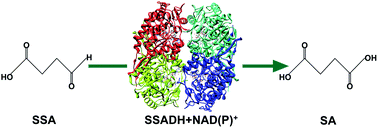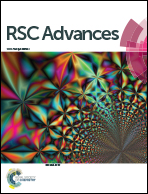A QM/MM study of the catalytic mechanism of succinic semialdehyde dehydrogenase from Synechococcus sp. PCC 7002 and Salmonella typhimurium†
Abstract
Succinic semialdehyde dehydrogenase (SSADH) belongs to the aldehyde dehydrogenase (ALDH) superfamily, which oxidizes succinic semialdehyde (SSA) to succinate (SA) in the final step of the degradation of the inhibitory neurotransmitter γ-aminobutyric acid (GABA). In this article, the catalytic mechanism of SSADH has been studied using a combined quantum mechanics and molecular mechanics (QM/MM) approach on the basis of the crystal structures of SSADH from Synechococcus sp. PCC 7002 (SySSADH) and Salmonella typhimurium (StSSADH). Our calculations reveal that, for SySSADH, the acylation process of substrate SSA is relatively difficult owing to the fact that the catalytic cysteine residue has already formed an adduct with the cofactor (NADP+), which corresponds to an overall energy barrier of 18.2 kcal mol−1. However for StSSADH, the cysteine residue exists as the thiolate ion and the acylation process is easily occurs, corresponding to an overall energy barrier of 9.6 kcal mol−1. In the subsequent deacylation process, using SySSADH to construct the computational model, the activation of the hydrolytic water molecule is concerted with the formation of a thioester intermediate, which is the rate-limiting step for the deacylation process, corresponding to an energy barrier of 18.2 kcal mol−1. Thus, for SySSADH, both the acylation and deacylation are possible rate-limiting steps. The pocket residues such as S261, C262 and S419/S425 play an important role in stabilizing the substrate and involved intermediates. Our calculation results may provide useful information for further understanding the catalytic mechanism of SSADH.


 Please wait while we load your content...
Please wait while we load your content...